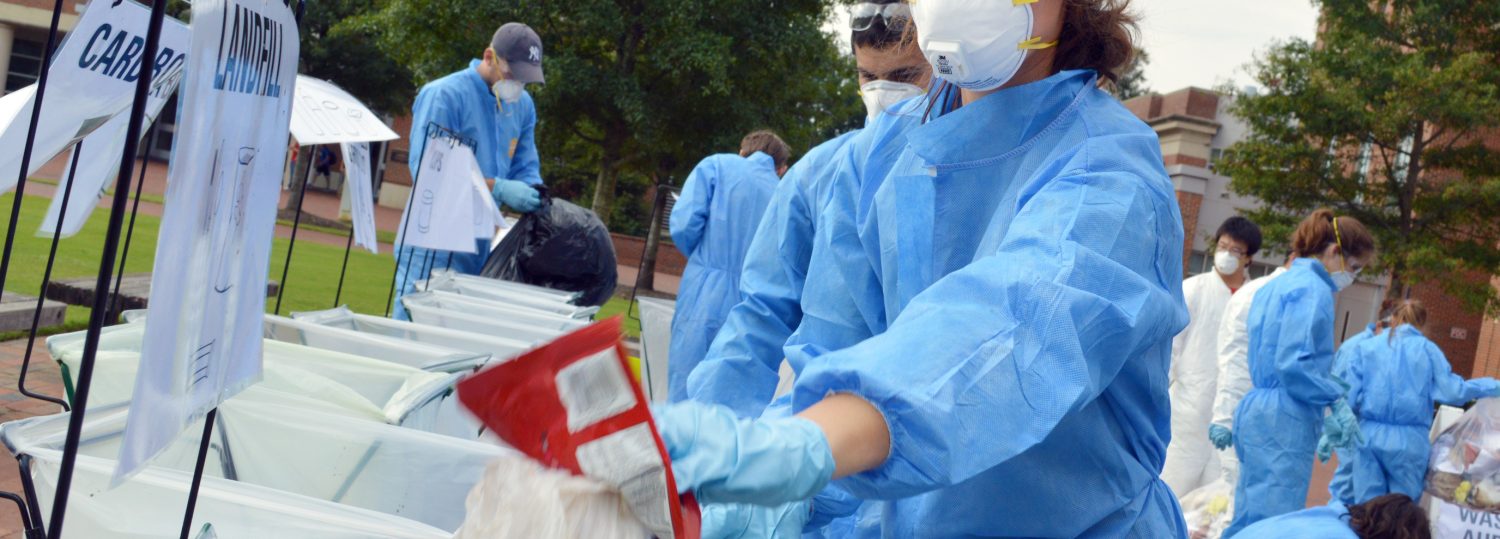Students in the LEED Laboratory Course are sorting waste from Nelson Hall. They are categorizing and weighing the waste to collect data about the waste that is generated within the building and understand more about waste generated on campus. Video courtesy of NC State News Services.
The following post is written by Kelsey Liu, a student in ARC 590, LEED Laboratory.
Friday, September 19, 2014
A class bringing together engineering, business, architecture and environmental students conducted a waste audit of Nelson Hall as part of the ARC 590, LEED Laboratory course. Students sorted, weighed and recorded two days worth of trash, recycling and cardboard coming from Nelson Hall’s dumpsters to determine if items end up in the proper receptacle. Students documented the process to help Nelson Hall qualify for the Leadership in Energy and Environmental Design (LEED) certification. The information gathered will be used to guide changes needed within the building to meet LEED criteria. This is one student’s account of what the process of sorting through trash, recycling and cardboard was like.
8:55 a.m.
On a brisk morning at the edge of Nelson Hall, I stroll up to two tents covering a bunch of boxes filled with Tyvek suits and other personal protection gear that we are required to wear. After we dress in the gear, we get a brief overview of the process. We split into three different categories – waste/trash, cardboard and recyclables – the same categories used for sorting. No one volunteers right away for the waste pile, but eventually 10 brave individuals walk over and start the stinky process. I was one of the lucky ones to sort cardboard. Our goal is to sort, weigh, record and recycle the cardboard.
As we watched the truck lower a dumpster’s worth of sopping wet cardboard into a pile, we quickly realize that every category is bound to make you dirty. Luckily, our pile doesn’t smell. We only get the down wind smells of the trash pile from time to time. Once we adjust the calculation to account for the water weight, we record the weight and the cardboard is then thrown into a bin, which is wheeled to a recycling bin. This process happens over and over.
9:41 a.m.
As I am taking the already weighed cardboard to the recycle bin, I rip my suit on a piece of metal. I head back to get a new suit and I am greeted with the job of waste weigher and recorder. I jump at the chance, thinking it will be exciting to see everything come and go and be able to calculate the amount of waste going through. I liked the sorting process better. There is a lot of waiting around for the bags to be filled before they get weighed.
9:53 a.m.
The cardboard group is finished and starts to help the waste team sort through the big trash pile. As I record waste numbers, I begin to compile the cardboard recycling numbers. In just two days of collection, there were 364 pounds of cardboard including a range of boxes from Amazon shipping to Panera catering. Everything but the pizza boxes was recycled. Judging by the amount of shipping boxes in the recycle pile, it doesn’t look like Amazon is going out of business any time soon.
10:12 a.m.
The recyclable materials group is finished. Looking at the numbers, eight pounds of waste ended up in the recycling dumpster. We all reflect on how can we help others be more conscious of where they throw their trash. In total there were 332 pounds of recyclables collected in two days, or around 150 pounds a day – which is equivalent to recycling an average sized human every day!
11:26 a.m.
The waste pile is done. Every last little piece is sorted and the tarps are rolled up. While sitting there and crunching numbers, I realize how much is being wasted. If only people knew.
11:34 a.m.
We have a quick meeting with our instructors to go over what we learned and what we thought about the waste audit. I finish adding the numbers for the trash pile and there is 824 pounds of waste. Of that total, 251 pounds could have been recycled. Just by looking at these numbers we recognize the need to educate people on why recycling is important. Over a quarter of the trash pile could have been recycled. We leave and head back to our areas, taking with us the knowledge that we collectively sorted over 1,500 pounds of trash in two days and ponder one last lingering question – what can we do to cut back on all the waste?
